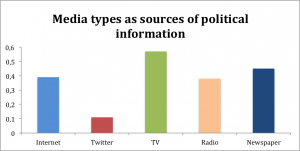By Katherine V. R. Sullivan (Université de Montréal)
What is the story?
There is a consensus that voters are politically uninformed, which can have repercussions on their decisions. Indeed, their vote choice may or may not be a true reflection of their values, opinions and beliefs. Regardless, there are many sources of information during an electoral campaign that may help reduce the informational gap. With the ever-rising popularity and accessibility of digital tools, there is considerable debate on the potential of new media vs traditional media.
On one hand, the new media allow users instant access to multiple sources of information, lower physical barriers and provide a digital public sphere where citizens, journalists and politicians alike can discuss. On the other hand, Internet may simply be a new playing ground for spin-doctors, greater polarization of opinions and digital echo chambers.
Data
Data from the Making Electoral Democracy Work (MEDW) surveys can provide useful insights on this question. Hence, I have analysed data from the 2012 provincial elections in the province of Quebec and the Ontario 2011 election in order to determine what types of media were most used by Canadian voters to acquire political information during the election.
Media types were divided into two categories: new media and traditional media. By new media, we mean Internet and Twitter. The traditional media are the radio, television and newspapers.
What’s popular? What’s not?
Figure 1. Media types as sources of political information
Note: Respondents were asked to rate their use of different types of media on a scale from 0 to 1.
As is shown in figure 1, television was by far the most popular media during the two provincial elections. Indeed, Canadian voters preferred traditional media, such as television and newspapers, to Twitter. However, results show that the Internet was a more popular source of political information than the radio.
Table 1. Media use and socio-demographic characteristics
| Internet | TV | Radio | Newspaper | ||
| Age | -0.12* | -0.07* | 0.14* | 0.04* | 0.09* |
| Female | -0.09* | -0.02* | -0.01 | -0.05* | -0.09* |
| Education | 0.09* | 0.02 | 0.05* | 0.09* | 0.08* |
| Ontario | -0.10* | -0.05* | -0.16* | -0.06* | -0.06* |
| R2 | 0.08 | 0.05 | 0.07 | 0.03 | 0.06* |
| Constant | 0.53 | 0.14 | 0.53 | 0.30 | 0.38 |
| N | 1591 | 1571 | 1600 | 1593 | 1595 |
Note: OLS regression. The dependant variable is media consumption of political information (0 to1 scale). The independent variables are all dichotomised, Values of 1 indicate older than 35, female, and post-secondary education.
* p<.05
Table 1 shows the relationship between the use of the various media and age, education, gender, as well as the differences between the provinces of Ontario and Quebec. We see, as expected, that younger respondents are more prone to use the internet and twitter while the reverse holds for the traditional media. The level of education is also significant in the choice of media. Canadian voters with higher levels of education – post-secondary education in this case – prefer the Internet, radio and newspapers. Finally women tend to make less use of all media sources, both new and traditional.
There is also a discernable difference in media consumption between the two provinces as is shown by the Ontario variable. Quebeckers are more intensive users of all media, both new and old, an indication that they were more interested in general in the provincial election, as indicated by a higher turnout.
Overall, although the Internet holds great promise for access to information and political leaders, it has yet to reach as great an audience as traditional media such as television and newspapers. We see, however, that there is a big age gap in the use of digital and traditional media, and so among youth the Internet has become as important as TV. There is also an educational cleavage, with the better educated making greater use of the internet but that cleavage is very similar to that found in the case of radio and newspaper. The same verdict applies to the gender gap: women make less use of all media. In short, those who use the internet are also those who use the traditional media, with the exception of the young, for whom the internet is becoming a very important source of information.


One Comment
As your set of dependent variables are probably highly correlated, and the correlations would be substantively interesting, seemingly unrelated regression might be a good idea if you want to develop this further…